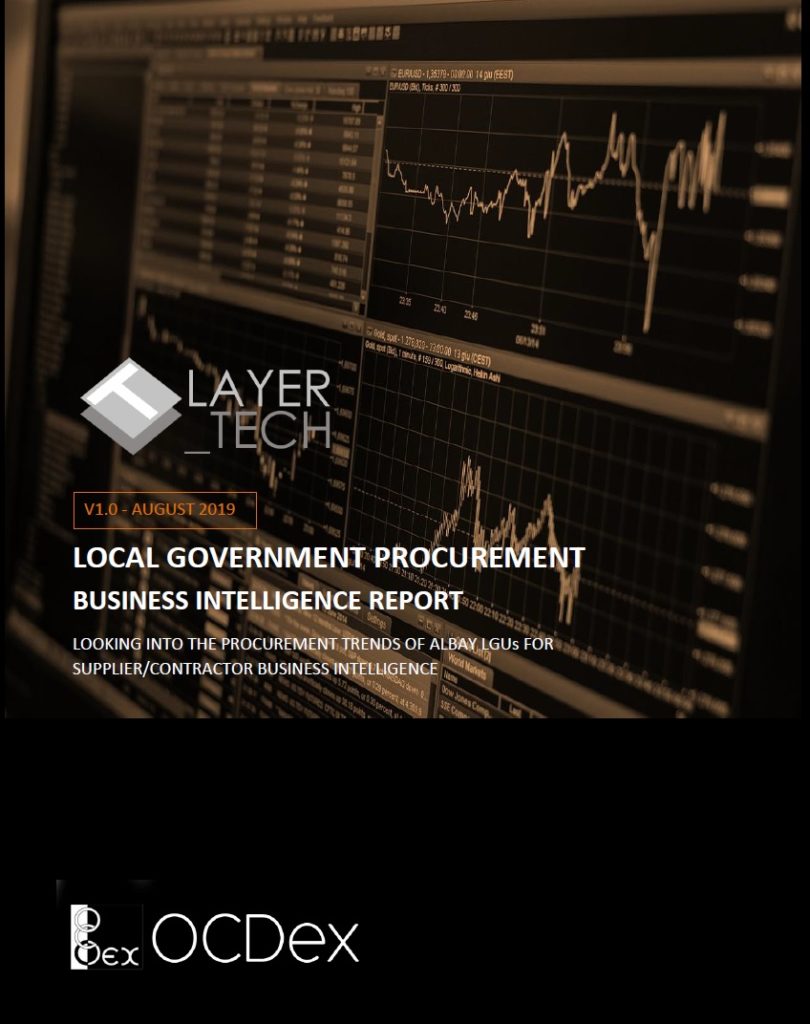Layertech Labs: Business Intelligence in Action
By Adelle Chua
Imagine you are a business owner in a city south of Manila. The thought of doing business with the local government has crossed your mind, but many reasons have somehow prevented you from doing so.
You could be operating on the notion that doing business with government is a hassle – they do not pay on time, they prefer to deal with the same companies, they are fraught with corruption and inefficiency, and it is manned by unprofessional, unreliable employees.
Or it could be that you just don’t know where to begin.
You have some pressing questions: What does the government even need, and how much do they usually spend on what type of projects? How long does the entire process take? What are the profiles of their current suppliers?
As a local business owner, your first instinct is to ask around. But if you don’t know that many people, or if you don’t have many connections among your fellow private sector players, much less at the local city hall, you will find yourself lost and unable to gather the information you need.
With all this to consider, you may eventually decide that being a supplier to the government is not a good option for you – all before you actually tried. What a missed opportunity, both for the Local Government Unit (LGU) and the business.
This is a scenario that Layertech Labs seeks to prevent. In August 2019, Layertech, together with Bicol University, and with support from Hivos’ Open Up Contracting Program, published “Local Government Procurement: A Business Intelligence Report” at its OCDex.tech portal.
OCDex.tech is a one-stop online repository, directory, and analytics platform of procurement information established by Layertech Labs with support from Hivos.
The report looked into the procurement trends of 18 LGUs in Albay province– 14 municipalities, three cities and the provincial government – intended to help suppliers be more efficient and competitive when joining government procurement.
A decision-making tool
Business Intelligence is the practice of systematically transforming raw data into useful information. It gives a clearer picture of what exactly is happening in the business process, narrows down potential problems, and serves as guide in asking the right questions.
In turn, an organization can make informed decisions, monitor performance and optimize resources.
In the context of open contracting, BI allows bidders and potential suppliers to know what the demand is, and allows them to plan their bids.
Asking the hard questions
To surface the issues most pertinent to the private sector, Layertech conducted a focus group discussion (FGD) among contractors in Albay province – members of the Albay Chambers of Commerce and Industry.
Based on the FGD, there were six items that the business owners specifically wanted to know – from the specific goods and services that the LGUs were buying, to the length of time it takes for them to pay the contractors. The questions are practical and commonsensical, but answering them based on historical data proved to be a daunting academic and technical exercise.
As a result, only four of the six questions could be answered given existing data, to note:
- What are the local governments buying? Most government tenders were in the form of construction projects and materials (based on the number of tenders).
- How much are the local governments spending? Local governments spend the most on construction first and vehicles, parts and fuel second (based on the average approved budget of contract per business category).
- How long is the procurement process, from posting of tender to actual contracting? There was a potential bottleneck in the issuance of the Notice to Proceed and/ or Publishing of Awards, and that the number of tenders spiked from the month of July, going up until December, while the lowest number of tenders are posted from February to June;
- Who and how many are currently supplying the local governments? For categories such as ‘Construction Projects and Supplies’, ‘Vehicles and Vehicle Parts’, and ‘Newspaper Printing, and Advertising Services’ there were a relatively smaller number of suppliers in vis-a-vis the number of tenders. Meanwhile, ‘Agriculture’, ‘Medical Supplies and Medicine’, General Merchandise’ and ‘Information Technology’ have the highest number of unique suppliers relative to the number of tenders posted.
Because of the limitations of available data, no answer could be given to two remaining questions:
- How many bidders participate in every tender?
- How long does it take for the local governments to pay the suppliers after successful delivery?
Working on available data
The Government Procurement Reform Act and its Implementing Rules and Regulations require all procuring entities to post all procurement information in a portal called PhilGEPS.
In theory, this is good. In actual practice, however, the gathering of all procurement information is much trickier and more challenging.
The PhilGEPS data contain thousands of rows from procuring entities. Values have inconsistent names, date and time formats. Often, documents uploaded by the entities are not machine-readable.
It was daunting work to “clean” the data sets from years 2016-2018 and make them consistent so the information could be processed, visualized and analyzed.
Recommendations – and a caveat
Painstaking work has allowed Layertech and its partners to come up with such visualizations and interpretations of data. However, they are quick to remind the users of information that the analysis was limited to data from PhilGEPS. They recommend that it be “layered and compared vis a vis other industry-related data and visualizations, for a more complete picture.”
Notwithstanding these limitations, the Business Intelligence paper for the province of Albay is a good start for any business owner curious enough to explore possibilities of doing business with the government – in an open and transparent manner.
As the quality of data improves over time, so would the insight that would be available to businesses and other users of information. For now, what was clearly demonstrated was that it could be done. With lofty objectives, determined stakeholders, coupled with hard data from the ground, the possibilities could be endless.

–Business Intelligence Report
Year : August 2019
Writer : Layertech
File type : pdf
DOWNLOAD



